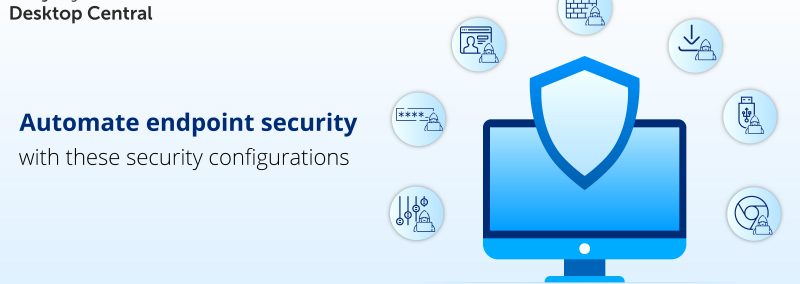Security configurations are security-specific settings used to secure heterogeneous endpoints such as servers, desktops, laptops, mobile devices, and tablets. As endpoints in your network diversify, securing each endpoint becomes a challenge. One way to ensure effective endpoint security is by automating it, which is where security configurations come into play.
Security configurations are utilized to secure and control every facet of your network. The National Institute of Standards and Technology (NIST) defines security configuration management as the process of controlling and managing security configurations to jump-start comprehensive security.
In this two-part blog series, we’ll discuss seven reasons security configurations are crucial for your organization, and the configurations you must implement for comprehensive security. In this part, we’ll look at seven reasons your organization needs security configurations:
1. Default security settings could be your worst enemy.
While onboarding endpoints with the default security settings intact is convenient, it’s not always recommended for security reasons. By not configuring the default settings, you are serving your organization’s confidential information on a silver platter. Failure to change the default security settings will pave the way for cybercriminals to effortlessly exploit your network, as these are known vulnerabilities.
2. Weak passwords are the third most common cause of ransomware attacks globally.
A survey conducted by the UK’s National Cybersecurity Centre divulged that 23.2 million victim accounts used the password “123456,” and more than 3.5 million people used “password” as their password for classified information. Simply put, weak and reused passwords pose a huge security risk. Therefore, using hard-to-guess passwords is critical for protecting sensitive information.
3. Poor privilege account management can result in devastating breaches.
A recent survey from privileged access management company Centrify revealed that a huge number of breaches originate from poor access management. The study found that a staggering 74 percent of respondents found that the breach they experienced involved privileged account access. Considering the high number of endpoints and users in many organizations, it can become overwhelming to keep tabs on access permissions granted to every user and entity. Access to classified information should be granted only when absolutely required.
4. Compromised firewall security is considered the low-hanging fruit.
Your firewall is the first line of defense against cyberattacks. Breaching firewall security is almost always one of the first steps malicious actors take when attempting to attack your network. Besides monitoring network traffic, firewalls can identify and block unwanted traffic. With a stable set of policies in place to strengthen firewall security, you can keep many attacks at bay.
5. Seventy percent of cyberattacks exploited vulnerabilities with available patches.
Considering the huge number of attacks that exploit known vulnerabilities, patch management is undeniably important. However, most IT administrators shudder at the thought of patching endpoints manually. Manual patch management can often turn into a wild-goose chase rife with human errors that ends up wasting a substantial amount of time, often resulting in this task being postponed or neglected entirely. This gives an edge to cybercriminals looking to exploit these vulnerable, unpatched devices.
Automating patch deployment can simplify and expedite the entire patch cycle. This ensures that you won’t overlook any critical vulnerabilities and will help you combat zero-day attacks seamlessly. Besides increasing the productivity of your IT team, automating patch management fortifies your network security.
6. Removable media can pose a major threat.
The use of peripheral devices such as USBs is inevitable, and utilizing them in your network without regulation can result in loss of corporate data. In fact, USBs are still one of the most common ways users exfiltrate classified information. Therefore, it’s important to monitor portable device use closely and grant access selectively.
7. Chrome is the most vulnerable browser as of 2019.
Browsers are used by nearly every employee for corporate and personal purposes, and are the primary interface for accessing the internet. Web browsers are, unfortunately, also the most accessible and straightforward avenue to stem cyberattacks. Every aspect of browsers, such as the browser history, extensions, plug-ins, cache, and cookies, can be leveraged by malicious actors carrying out cyberattacks on endpoints. Of all the web browsers, Google Chrome currently dominates the market with a share of 67 percent. This makes securing your browsers all the more significant.
While your browser history establishes your behavioral pattern, cookies are repositories of site information on your endpoints. Extensions and plug-ins are an inherent part of browser usage that contain vulnerabilities that can be exploited effortlessly. And when considering the plethora of available web browsers, configuring and streamlining browser-specific settings can get overwhelming.
Now that we’ve learned why security configurations are so crucial, it’s time to tackle implementation. Stay tuned for part two where we’ll dive into eight security configurations your organization must implement to secure all its endpoints.

